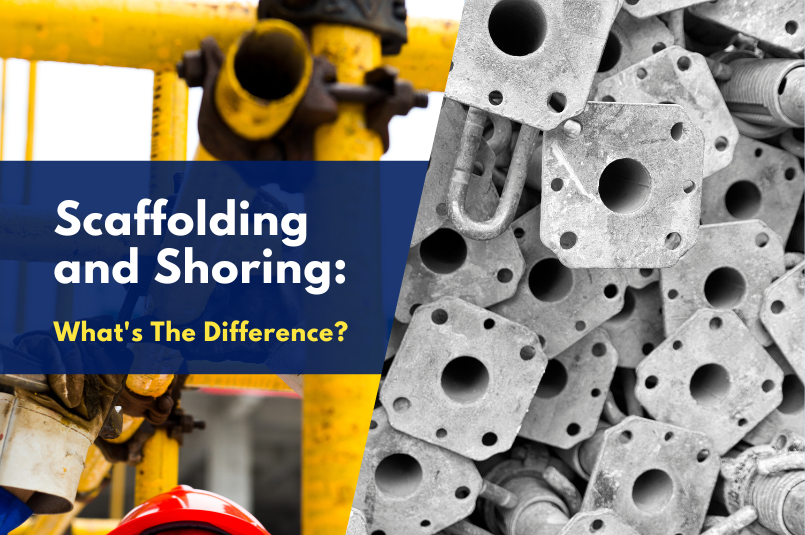
Scaffolding and shoring are construction equipment that supports the movement of workers and materials in areas with light to moderate seismic risk. Both of these systems facilitate easy access to worksites. However, they differ in many ways. This blog will help you understand the differences between scaffolding and shoring, how both are used in construction projects, and how to choose the right type of scaffolding supplier in the USA for your project.
What is scaffolding?
Scaffolding is a type of construction support used to reach high areas or build structures above ground level. It is most commonly used in construction to provide a stable platform for workers and materials and can be made from a variety of materials, including steel, wood, and concrete.
Scaffolding’s many advantages make it an integral part of any construction project – from quickly creating a workspace high above the ground to providing safe access to difficult-to-reach areas.
Scaffolding parts have many applications in construction, but perhaps the most common use is as a temporary work platform during building renovations or repairs.
When using scaffolding braces or scaffolding wheels for a project, safety should always be foremost in mind. Different types of scaffolding have different safety requirements based on the structure’s height and use, so it’s important that you understand the limits of each type before using them.
What is shoring?
Shoring is a construction technique used to hold up walls, ceilings, and floors that are unstable or weak. It can also be used to help support structures while they are being repaired.
Shoring is typically made of wood, steel, and aluminum. The materials chosen depend on the size and weight of the structure that needs to be shored up.
For example, larger buildings may require steel shoring while smaller structures like residential homes may only need wooden beams.
Shoring materials are often connected with nails or screws and then reinforced with heavy-duty steel brackets for extra stability. In addition, some types of shoring systems can even be adjusted over time as the structure changes shape or size due to settling or seasonal changes in temperature and moisture levels.
Differences between scaffolding and shoring
Types of Support
Scaffolding and shoring are two different types of supports used in construction. Scaffolding is usually used for construction, while shoring is used to support existing structures.
Design Factor
Scaffolding has a rigid design that allows the use of more complex shapes and configurations than shoring, which requires additional safety measures due to its more flexible design. Scaffolding is designed to withstand high forces, while shoring is designed for low forces.
Materialistic Aspect
Shoring requires thicker material than scaffolding, making it safer for people to work on.
Convenient and Suitable
Scaffolding is designed to withstand high forces, while shoring is designed for low forces. This difference in strength makes scaffolding more suitable for construction activities that require a higher level of stability, such as building scaffolds or temporary platforms.
Cost
On the other hand, shoring is less expensive and easier to install than scaffolding.
Durability
Scaffolding is a temporary structure used to provide access for workers and materials to areas that would otherwise be inaccessible or difficult to reach during construction. It is made up of lightweight aluminum or steel tubes connected by couplers, which can be adjusted and reconfigured to meet project requirements.
Shoring, on the other hand, is designed for a more specific purpose – it’s used to hold back earth or material from an excavation site so that further work can be done safely without risk of collapse.
Uses of scaffolding and shoring
- Shoring is used for support during deep excavations, such as in construction sites.
- Scaffolding is used for providing access to areas that require work or inspection.
- Shoring is also used for supporting an individual structure during heavy construction works like pouring concrete or underpinning walls with bricks or blocks.
- Scaffolding is also used for providing access to work areas and other elevated surfaces.
Both forms of support are essential for large-scale construction projects, but shoring is more commonly seen in industries like mining and civil engineering, while scaffolding is more commonly seen in industries like healthcare and education.
Benefits of using scaffolding and shoring
- Scaffolding and shoring are two different construction techniques used to safely access hard-to-reach areas.
- Both scaffolding and shoring services provide a safe and secure platform for workers to stand on, which helps increase productivity and safety on the job site.
- Scaffolding can be removed and reused, making it an economical choice for many projects. Scaffolding also provides a safe and secure working environment for workers, which prevents accidents. While scaffolding is a great tool for increasing visibility, shoring is an effective way of ensuring stable footing for heavy loads.
- Shoring can be used in the construction of walls or slabs, preventing the accidental collapse of the structure during construction. Additionally, shoring helps to prevent soil erosion during heavy rains or winds, increasing the long-term stability of the structure.
Therefore, both scaffolding and shoring have their own unique benefits that can help increase productivity at the job site.
How do you choose the right type of scaffolding or shoring for your project?
There are many types of scaffolding and shoring services to consider when carrying out work on a building, but it’s important to understand the purpose of each type of scaffolding or shoring.
- When choosing the best scaffolding suppliers in the USA, consider the size and scale of your project.
- Load capacity (the maximum weight that the scaffolding can support) is an important factor to consider when selecting scaffolding.
- Also, take into account local regulations and safety standards for scaffolding, as different jurisdictions may have different requirements.
- Finally, invest time in researching the types of scaffolding that are best suited for your project.











Comments are closed